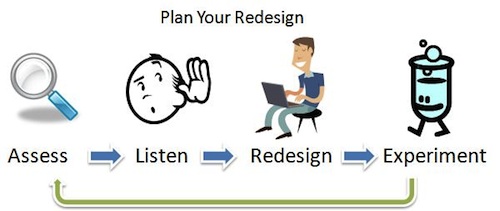Have two job interviews this week, and am also working freelance for another group right now — in all three cases, the organizations admit their website is “rough” and want to see a re-design of it. They have coders/developers and they have content people, but they aren’t sure exactly what to focus on to make it the right experience for whatever their core business function is (provided that’s been defined for them). I’d say in the last 10 months, I had 60+ interviews where some group was re-designing a website. I always kind of figured it was an offshoot of the popular corporate game of changing things on a dime for no real reason except that someone saw something in some other place that looked better than the something we have, or whatever the case may be. But now I’m thinking about it a little differently — first off, there are ideal factors in terms of how content gets seen and shared, but there’s also this, from the Forrester blogs and an interview with John Maeda, who works on design with Kleiner Perkins and eBay:
What is now clear in the consumer technology space is that we instinctively know that we don’t need more storage or speed because we don’t have any real use for it. In absence of the normal cues of “better,” which used to be as simple as knowing the CPU’s clock speed, or how much RAM it has, or how big a screen to pair with it, we now are choosing based upon something else: design. Because more computing power no longer makes technology feel better — in fact, the pile-on of new features that Moore’s Law has enabled makes us feel confused. And in this new universe, we have come to count on design to cut through the clutter and make things feel better. In the past couple of years, we have seen increasing consensus around this point, so it will be interesting to see where that takes us.
Design = not necessarily about beauty on face, but about cutting through clutter. Agree with that 1800 percent. Tons of these organizations I’ve talked to want flashy things or social buttons or XYZ colors — and those are all important — but the real key is: when someone gets to that site, do they know what the purpose of the organization is, and do they know where they should go (where you want them to go)? Remember, Google is perhaps the most popular and relevant website of the modern era. At its core, it’s just a box that you type in. Simplicity. And make things feel better.
